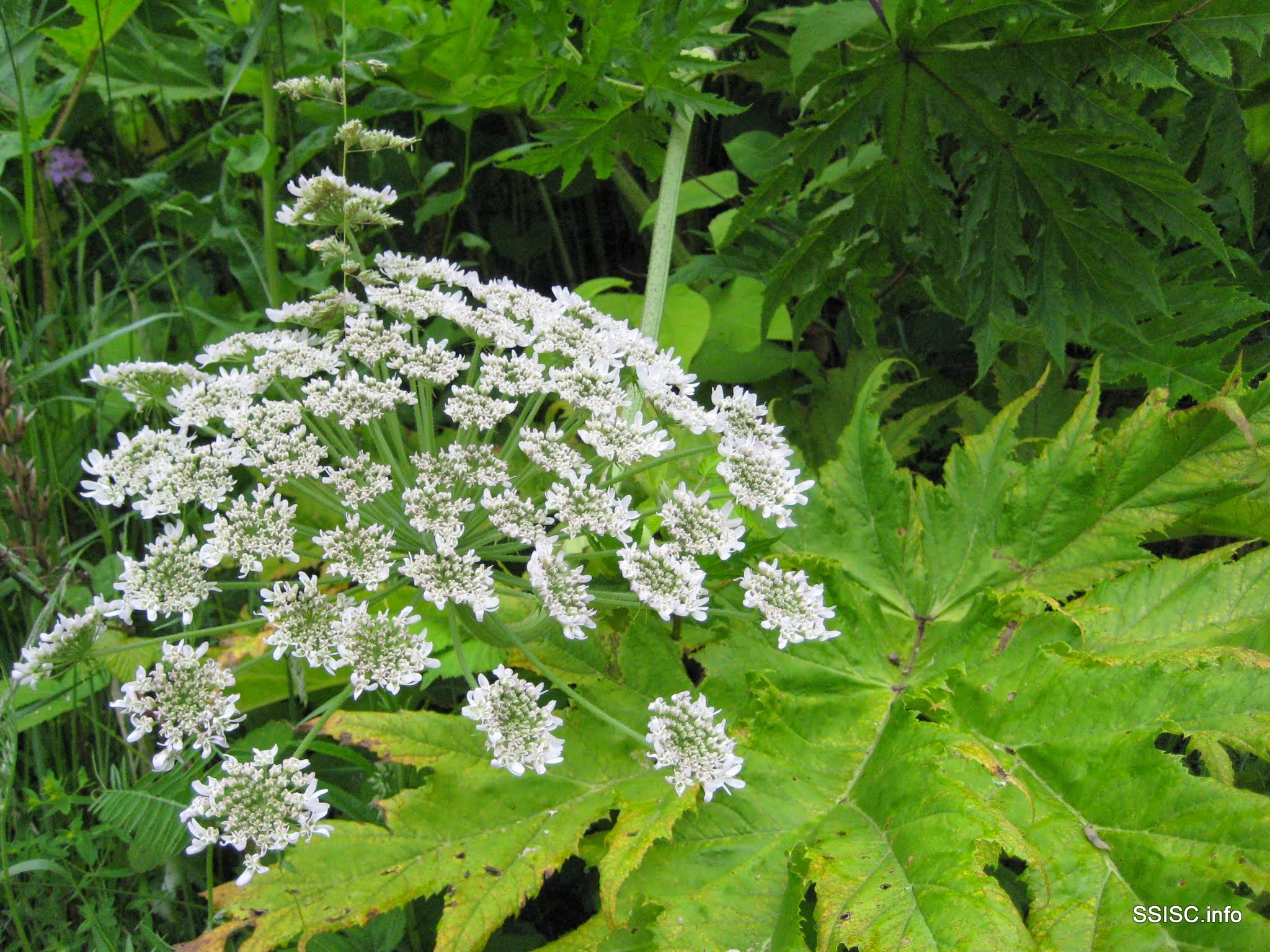A plant so giant it rivals towers,
with spiky leaves and umbrella-like flowers.
Its sap burns your skin when in the light of day,
and its shallow root system makes soils wash away.

I Spy in the Sea to Sky…
This extremely toxic plant can grow up to 5 meters tall! Can you guess what it is?
It’s Giant Hogweed (Heracleum mantegazzianum)! It flowers from May to August, and thrives in disturbed areas with wet soil. Originally from Southwestern Asia, watch out for it along streams and rivers, or along forest edges. Giant Hogweed is a high-priority plant in the Sea to Sky. We aim to eradicate it from the region, as per SSISC’s priority plant species list. It is listed as noxious in the provincial BC Weed Control Act, and is one of Squamish’s Most Wanted.
Giant Hogweed can be easily identified by several distinctive features:
- Numerous, small white flowers arranged in a large umbrella-like clusters.
- Tall stems (2 to 5 meters!) with reddish-purple blotches along the stem.
- Leaves are a similar shape to maple leaves, but much larger and deeply incised.

What should I do if I see Giant Hogweed?
Giant Hogweed contains an incredibly toxic sap. Do not touch this plant!
Thankfully, Giant Hogweed has a limited distribution in the Sea to Sky, so sightings are relatively uncommon. If you see this species, the first thing you should do is report the sighting to SSISC. Do not attempt to remove this plant on your own.
If you touch this plant by accident, wash the affected area immediately with soap and cold water, and protect the area from sunlight for at least 48 hours after exposure. You can learn more about what to do after being exposed to Giant Hogweed on Worksafe BC’s website.
Does Giant Hogweed have any look-alikes?
Yes, the native Cow Parsnip (Heracleum maximum) is often mistaken for Giant Hogweed. However, Cow Parsnip is much smaller and more common than Giant Hogweed. Beware though, both Cow Parsnip and Giant Hogweed contain a toxic sap that can cause severe burns, so avoid touching either one of these plants!

Why is Giant Hogweed such a concern in the Sea to Sky?
Giant Hogweed contains a clear, toxic sap that, when exposed to sunlight, can cause severe burns, blistering and dermatitis. This sap is found in all parts of the plant, so avoid touching the plant, handling plant material, or even touching tools used for controlling Giant Hogweed.
This plant is also highly competitive due to its vigorous early-season growth; ability to coexist with other aggressive growers; and tolerance of shade and seasonal flooding. Infestations can result in increased erosion hazards in riparian areas due to characteristically shallow roots.
Giant Hogweed forms a robust seed bank, as one plant can produce up to 10,000 seeds, and these seeds can remain viable for 15 years. Giant Hogweed seeds may spread by floating down water, or through the transportation of contaminated soil.
The management costs to control Giant Hogweed infestations worldwide are incredibly high. According to the Invasive Species Council of BC, in Germany, the management costs for Giant Hogweed are about $17.5 million (CDN) annually.
If you want to know what you can do to help, read more about Giant Hogweed on its species profile page.
I Spy in the Sea to Sky Contest
Guess the invasive species in our I Spy in the Sea to Sky weekly social media post, June through August, to enter our giveaway.
At the end of each month, one lucky commenter will win a native wildflower seed mix packet! Follow us and comment on social media to participate!
CONTEST RULES:
- Comment your guess (common or species name) on the social media post (on Instagram or Facebook) to enter. Only correct guesses will qualify you for the giveaway.
- One entry per person per post.
- Anyone can play, but only Sea to Sky region residents can win.
- Entries will close at 11:59 PM PST on June 30th, 2024.
- Winners will be announced in the first week of July in an Instagram story AND contacted directly via their platform of entry.






Add Comment